| Feb-20-02 | | knight: White surrounded The key black d-pawn and captured it. |
|
Feb-20-02
 | | Sneaky: I like that move 5. a3, it takes a lot of wind out of Black's sails. There are some amazing variations in this opening where Black wins brilliantly with a timely Bb4+ including one where Black promotes to a Knight (!) in the opening. But simply the preventative a3 shuts down all that. |
|
| Apr-05-08 | | vonKrolock: <22...♗d5> The move 22...♖h6 suggests itself now, in order to answer 23.♗xb7 with 23...c6 - a double attack over `g5` and `b7` - Δ to win a whole piece at once. The reply 24.♘f3 is obviously forced - now, after 24...♖d5 black pieces are all active, while white`s suffer from lack of coordination - there`s a lot of play in perspective, and the white`s ♙ plus here means almost nothing |
|
| Mar-17-17 | | Saniyat24: <kevin86> you can include this game in your Janowski's gems....although this one is not annotated by Janowski... |
|
Jul-10-21
 | | KEG: Janowski was flying high at the time of this game.
He had taken first place at Monte Carlo 1901, and had scored two wins and a draw (against Maroczy, yet to be replayed) in the first three rounds here at Monte Carlo 1902. With this win (and even without the replay of his 3rd round draw--which itself was drawn), this win over Tarrasch put him in first place ahead of Marshall and ahead of Mieses (who had won his first three games but had a 4th round bye). Soon enough, Janowski came down to earth and finished thrid behind Maroczy and Pillsbury. Meanwhile, Tarrasch, who had not played a significant tournament since his victory at the monumental Vienna 1898 tournament, was obviously out of form, and his come-back started poorly. He had lost a difficult game against Tchigorin in Round 1, blundered away a won ending against Marshall in Round 2, drawn his third round game against Gunsberg (Tarrasch won the replay the day after the instant game) and now blundered here he blundered away a favorable position against Janowski. At the finish of this game, Tarrasch had scored (under the scoring system in effect at Monte Carlo 1902) only 1/4 of a point for his first four rounds (soon to be 3/4 of a point when he won his replay against Gunsberg). Tarrasch, great player that he was, soon recovered at least some of his form and ended up in a three way tie for 5th with Schlechter and Teichmann). Had he won this game, as he probably should have--and likely would have once back in form--Tarrasch and Janowski would have tied for 4th place. One can see Tarrasch''s formidable positional judgment in parts of this game, and he--contrary to all of the commentary I have seen on this game--was almost certainly better through at least move 20, and was basically OK until his poor 23rd move and his blunder on move 24. Unfortunately, some portions of the score for this game (for which there are differing versions) seems fouled. We do, however, probably have a correct score through move 24, by which time Tarrasch was lost. The commentary on this game by Hoffer seems dreadfully bad. I suspect, however, that this commentary may in fact be fouled (Hoffer's reference to 17...Bxc4 being a good alternative looks like a typo). As with Tarrasch's earlier games in this tournament, his play in this game is often painful for his latter-day fans to watch. As for Janowski, some of his early play was aggressive and exciting and would perhaps have carried the day at the initial stages against a less formidable opponent. As for the latter part of the game, Janowski showed up and took what Tarrasch handed to him. 1. d4 d5
2. c4 e5
The Albin-Counter Gambit. Tarrasch, rather curiously, took on this opening (for the first and last time in his career so far as I am aware) at Monte Carlo 1902, losing to Marshall in Round 2 after achieving a winning ending and losing to Janowski here, against because of later errors and not because of the opening. Tarrasch played the Albin again in a later round against Napier here at Monte Carlo 1902, this time achieving a draw. 3. dxe5
Marshall had played 3. e3 against Tarrasch in their Round 2 game. The text is likely best, and was also employed by Napier in his later game against Tarrasch. 3... d4
The most aggressive line.
4. Nf3 Nc6
5. a3
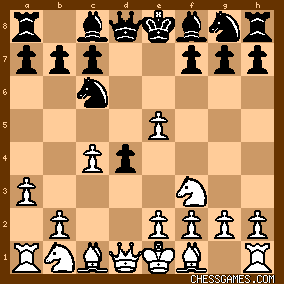
click for larger view<sneaky> likes this very Janowski-like move (similar to Janowski's employment of a6 as Black against the Queen's Gambit. The main alternatives are 5. Nbd2 and 5. g3. The text was introduced by Lasker back in 1893 in a game he won against Albin. 5... a5?!
Sharp, interesting, and risky play by Tarrasch. The opening play quickly becomes complex and very double-edged. Safer, but hardly promising equality, were 5...Nge7; 5...Bg4; and 5...g6. 6. h3
A novelty at the time. Marshall later played it at Canbridge Springs 1904. The simplest way for White to proceed with his development, however, was with 6...Nbd2 6... Bc5
Tarrasch refused to get distracted and calmly proceeded to develop his pieces. The position was now:
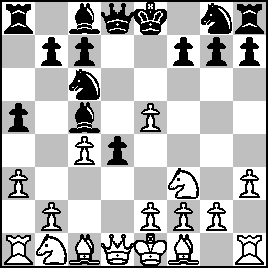
click for larger view |
|
Jul-11-21
 | | KEG: Post II
7. Bg5
Janowski was up a pawn thanks to Tarrasch's counter-gambit, but he was undeveloped. Thus, 7. Nbd2 immediately looks most logical here for White. But Janowski always liked to put his Bishops into action, and did so here even though this move helped Tarrasch develop his game. 7... Nge7
8. Nbd2 h6
9. Bh4
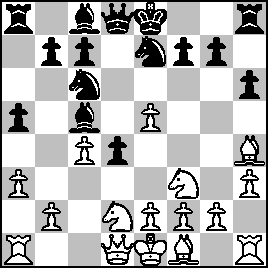
click for larger view9... Be6
Tarrasch might have opted to break the pin on his Knight immediately with 9...Qd7, but preferred to continue to develop even at the cost of having to endure the pin a while longer. 10. Rc1
A better plan to try to keep the advantage seems to be to play Ne4, Qc2, and then g4, bringing his other Bishop into the game while maintaining his extra pawn. So 10. Qc2 or 10. Ne4 look best. But, for whatever reason, Janowski doesn't seems to have fancied playing Ne4. 10... a4!
At least temporarily tying up Janowski's King-side. 11. g4! Qd7
Finally breaking the pin. But after Janowski's last move, Tarrasch might have challenged with 11...h5. 12. Bg2 Ng6
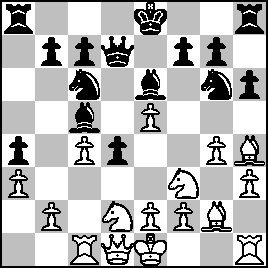
click for larger view13. Bg3
Janowski yet again declines to play 13. Ne4 (he might indeed have played Ne4 on his last turn as well as on his 10th move). At this point, chances were about equal, Janowski's extra pawn balanced by his disorganized position. 13... h5
14. gxh5 Rxh5
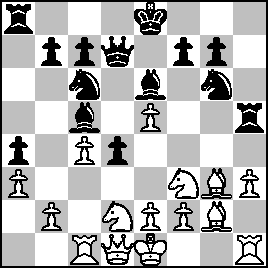
click for larger view15. h4
And once more, Janowski ignores the chance to play Ne4. 15... Ncxe5
The Tournament Book gives this move as 15...Ngxe5. If indeed the text was played rather than 15...Ngxe5, Janowski could and probably should have played 16. Ne4. 16. NxN NxN
17. Ne4
Finally! The position was now:
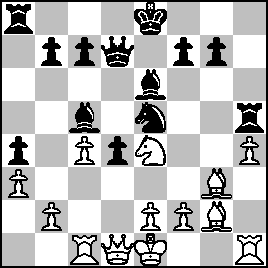
click for larger viewAccording to Hoffer, this was the key moment of the game. 17... Bb6
"?"--(Hoffer)
"The whole game hinges on this point. The game having been discussed after its conclusion, it was found that 17...Bxc4 could be played, or still better the simple 17...Be7. Black then had a decided advantage, whilst after the text move the, the whole fabric crumbles to pieces." (Hoffer) Huh? Nearly every statement by Hoffer in this quotation is wrong. For starters, 17...Bxc4?? loses a piece to 18. NxB. Perhaps Hoffer meant to say 17...Bxc4 (allowing the Rook to defend the c5 Bishop), but then the game is even after 18. e3 rather than a position in which Black has a :decided advantage. If 17...Be7, the game is also even (e.g., 19. Ng5 BxN 19. hxB RxR+ 20. BaR Nxc4 21. Qd3 Qb5 (not 21...Nxb2 22. Qb1! and White is better) 22. Qxd4 with approximate equality. More fundamentally, after the text, Black is entirely fine. Indeed, within a few moves Tarrasch emerged with much the better chances, the position after 17...Bb6 being: 
click for larger view |
|
Jul-11-21
 | | KEG: Post III
18. BxN?
Incredible from Janowski (the great lover of Bishops). He would have been fine with 18. Ng5. 18... RxB
19. c5
Janowski may have counted on this, but Tarrasch now had much the better chances. 19... Ba5+
20. Kf1 Bb3
20...Qb5 may have been stronger still.
The position was now:
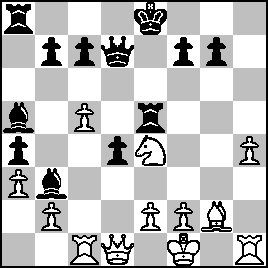
click for larger view21. Qd3
He might also have considered 21. c6 (21...Qxc6 22. RxQ BxQ 23. Rc1 Bb3). But even then Tarrasch would have been better. 21... Ra6?
Very weak. Tarrasch would have retained the better chances with 21...Qf5. Beginning here, he seemed to lose the thread of the game (to the extent the balance of the score can be relied on at all). 22. Ng5
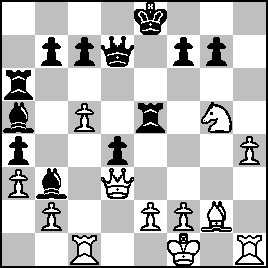
click for larger view22... Bd5
<von Krolock> here suggests 22...Rh6, but Janowski would then play 22. Nf3 (and not 22...Bxb7 as assumed by <von Krolock>) after which Black's edge would be lost. Best here for Black was 22...Rf6. Tarrasch's choice was worse than either of these options: 23. BxB
23. Rh3 or 23. Rg1 would have been better. But this move, whatever its theoretical merits, paid unexpected dividends, the position now (with Tarrasch to recapture) being: 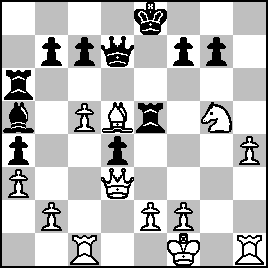
click for larger view23... QxB?
Black would be OK with 23...RxB, but now he was suddenly in trouble. 24. Rh3
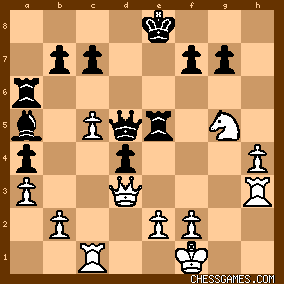
click for larger view24... Re7?
Tarrasch was clearly not back in form. This flat out loses. He had to play 24...Rf6 or 23...Rh6. But now the game was---or should have been--over: 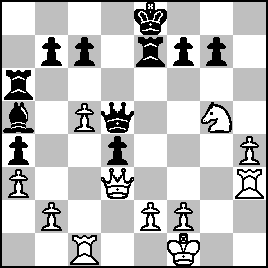
click for larger viewNow Janowski can win with 25. Rc4. But...
Beginning here the score is inconsistent. We can be reasonably certain that the above diagram represents the position reached after Tarrasch's 24th move. And we can be reasonably certain of the position after Tarrasch's 26th move. But in between...well...it's confusing. I will discuss the conflicting accounts (neither of which is satisfactory) of what occurred on moves 25 and 26 in my next post on this game. |
|
Jul-11-21
 | | KEG: Post IV
According to the Tournament Book, play from here went: 25. Rc4 (best) Rd7
26. Nf3 Rc6?
If this is correct, 26...Rc6? was awful. Tarrasch would be lost most likely anyway, but 26...Rf6 would have been the best try. This is not great, but the score as given on this site would be even worse: 25. Nf3?
Missing 25. Rc4 and giving Black a chance.
25... Rc6?
If Janowski did indeed play 25. Nf3?, then Tarrasch might have saved the day with 25...Qe4. Even 25...Rae6 would have been better than 25...Rc6? 26. Rc4! Rd7?
Unthinkably bad. Tarrasch should have tried 26...Qe4 or maybe 26...Re4, though he would have been theoretically lost anyway. After the text (if this is all correct), what followed was a massacre. Whatever the actual moves 25-26, it is apparently agreed by all that after Tarrasch's 26th move, the position was: 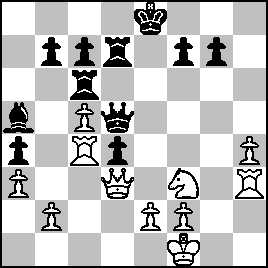
click for larger viewFrom here, Janowski cleaned up easily:
27. Rxd4
Ouch!
27... Qe6
Hopeless, but so is everything else.
28. Ng5!
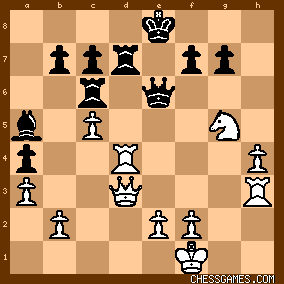
click for larger viewTarrasch should probably have spared himself the rest and called it a day here. 28... RxR
29. QxR Qd7
30. Re3+
This wins easily of course, but 30. Qxg7 was even more ruthless (30...Qd1+ 31. Kg2 Qd5+ 32. Kh2 Rxc5 33. Re3+ winning the Black Queen). 30... Kd8
If he wanted to play on (and why should he?) Tarrasch should have given up the exchange with 30...Re6. Even this, needless to say, would have given him no real hope. After the text, the rest was brutal:
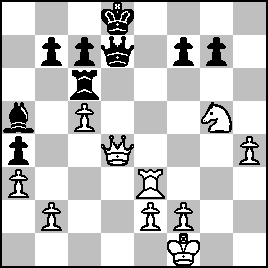
click for larger view31. Nxf7+
31. Qxg7 is again brutal, but the text also wins almost immediately. 31... Kc8
32. QxQ+ KxQ
33. Ne5+
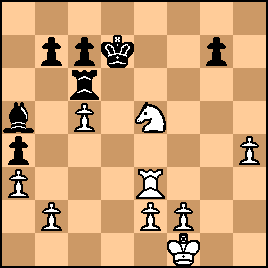
click for larger view1-0 |
|
Jul-12-21
 | | Pawn and Two: <KEG> The 1902 Monte Carlo tournament book, edited by A.G. Gillam, the New York Times report of 02/24/1902, and the Wiener Schachzeitung, May-June 1902, p.116-117, all show the game moves as: 25.Rc4 Rd7 26.Nf3 Rc6. Also, all three sources show that Black played: 15...Ngxe5, not 15...Ncxe5. Corrections to our database for these moves should be submitted. |
|
Jul-13-21
 | | KEG: <Pawn and Two> The correction on move 15 is certainly warranted. As for moves 25-26, neither of the versions is entirely satisfactory as a likely score. But the version you favor, having as it does three sources, is the best candidate. |
|
Jul-14-21
 | | Pawn and Two: <KEG> Yesterday I submitted a correction request for the indicated moves. This morning I noticed the corrections had already been made. Thank you for all your hard work. I find your comments and analysis of these old games and tournaments to be very instructive and interesting. |
|
Jul-14-21
 | | KEG: <Pawn and Two>Thank you for all your fine work and analysis. So glad you enjoy my posts. |
|
|
|
|





































